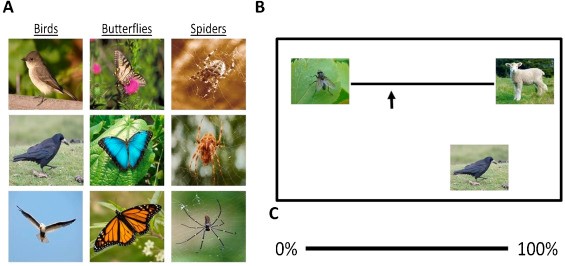
The Itsy Bitsy Spider?
February 3, 2016
Press Releases, Social Sciences & Humanities
BGU researchers have discovered that arachnophobes overestimate spider size compared with other neutral animals that do not elicit fear, which could be useful in treating phobias.
The new study published in the journal, Biological Psychology, consisted of two experiments measuring attractiveness (valence) and the self-relevance role in neutral (birds, butterflies) vs. aversive (spiders) animal size estimation.
“We found that although individuals with both high and low arachnophobia rated spiders as highly unpleasant, only the highly fearful participants overestimated the spider size,” explains Dr. Tali Leibovich, a Ph.D. researcher at BGU’s Department of Brain and Cognitive Sciences and the Zlotowski Center for Neuroscience.
The research was born from a lab experience when Dr. Noga Cohen noticed a spider crawling and her spider-phobic colleague, Dr. Leibovich, asked her to get rid of it. Dr. Cohen could not understand why Dr. Leibovich was afraid and thought the spider was small, while Dr. Leibovich insisted the spider was large. “How could this be if we both saw the same spider?” asked Dr. Cohen.
In the study, the researchers had female BGU students complete a questionnaire that measured their fear of spiders and divided the participants into two groups: afraid and unafraid. The results of the first experiment demonstrated that although both groups rated the spider pictures as more unpleasant than the other pictures, only the highly fearful participants overestimated the size of spiders compared to butterflies.

Fig. 1. Stimuli and procedure—Experiment 1. (A) Stimuli pictures—all stimuli were presented in the same physical size of 228 × 197 pixels. (B) An example of a typical trial. The same pictures of a fly and lamb appeared in every trial with the stimulus to be rated appearing in a random position underneath. (C) Visual analog scale (VAS): the left side of the line equals 0%, representing small conceptual size (closer to a fly) or low unpleasantness rating; the right side of the line equals 100%, representing large conceptual size (closer to a lamb) or high unpleasantness.
Further experiments showed that size estimation was affected by both the level of unpleasantness and the great fear a participant had of spiders.
“This study revealed how perception of even a basic feature such as size is influenced by emotion, and demonstrates how each of us experiences the world in a unique and different way,” says Dr. Leibovich.
“This study also raises more questions such as: Is it fear that triggers size disturbance, or maybe the size disturbance is what causes fear in the first place? Future studies that attempt to answer such questions can be used as a basis for developing treatments for different phobias.”
This work was supported by the European Research Council (ERC) under the European Union’s Seventh Framework Programme (FP7/2007–2013)/ERC Grant Agreement 295644 to AH.
ABOUT AMERICANS FOR BEN-GURION UNIVERSITY
By supporting a world-class academic institution that not only nurtures the Negev, but also shares its expertise locally and globally, Americans for Ben-Gurion University engages a community of Americans who are committed to improving the world. David Ben-Gurion envisioned that Israel’s future would be forged in the Negev. The cutting-edge research carried out at Ben-Gurion University drives that vision by sustaining a desert Silicon Valley, with the “Stanford of the Negev” at its center. The Americans for Ben-Gurion University movement supports a 21st century unifying vision for Israel by rallying around BGU’s remarkable work and role as an apolitical beacon of light in the Negev desert.
About Ben-Gurion University of the Negev
Ben-Gurion University of the Negev embraces the endless potential we have as individuals and as a commonality to adapt and to thrive in changing environments. Inspired by our location in the desert, we aim to discover, to create, and to develop solutions to dynamic challenges, to pose questions that have yet to be asked, and to push beyond the boundaries of the commonly accepted and possible.
We are proud to be a central force for inclusion, diversity and innovation in Israel, and we strive to extend the Negev’s potential and our entrepreneurial spirit throughout the world. For example, the multi-disciplinary School for Sustainability and Climate Change at BGU leverages over 50 years of expertise on living and thriving in the desert into scalable solutions for people everywhere.
BGU at a glance:
20,000 students | 800 senior faculty | 3 campuses | 6 faculties: humanities & social sciences, health sciences, engineering sciences, natural sciences, business & management, and desert research.
For all press inquiries, please contact:
James Fattal, J Cubed Communications
516.289.1496



